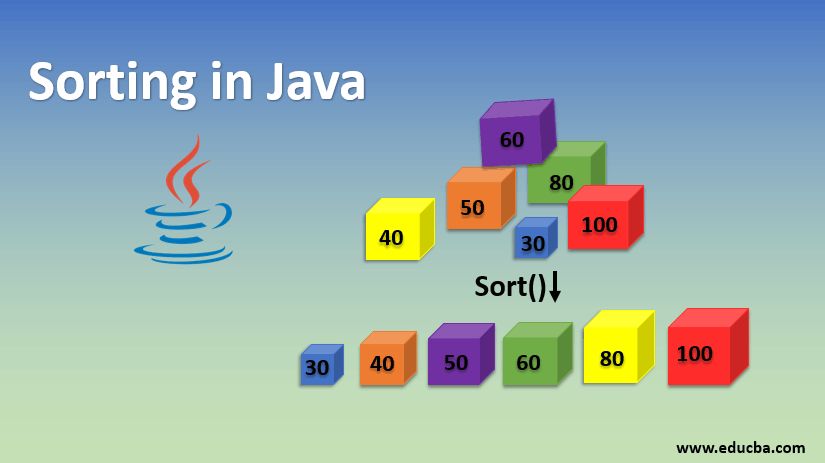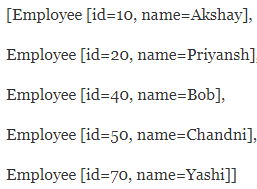Sorting in Java
Below mentioned are some of the ways through which sorting can be performed in Sorting in Java:
1. sort(array_name)
This is used to sort the complete array in ascending. By default, this method sorts the array elements in ascending order.
import java.util.Arrays; public class SimpleSort < public static void main(String[] args) < //Unsorted array of numbers Integer[] arr = new Integer[] ; //Sort function to sort the above array Arrays.sort(arr); //Printing the sorted array on console System.out.println(Arrays.toString(arr)); > >2. Collection.reverseOrder()
This method in Java is used to sort the array in reverse order or descending order. There are scenarios where we need to sort the elements in descending order, and Java does that through the built-in method.
import java.util.Arrays; public class ReverseSort < public static void main(String[] args) < //Unsorted array of numbers Integer[] arr = new Integer[] < 100, 20, 10, 30, 80, 70, 90, 40, 50, 60>; //Sort function to sort the above array Arrays.sort(arr, Collections.reverseOrder()); //Printing the sorted array on console System.out.println(Arrays.toString(arr)); > >3. sort(int[ ] array_name, int findex, int lindex)
If there is a need to sort some part of an array instead of the whole array, Java provides the facility to sort this type of array by specifying 3 parameters, i.e. array name, first index from where the sorting needs to be started and the last index till when the sorting needs to be done.
import java.util.Arrays; public class ReverseSort < public static void main(String[] args) < //Unsorted array of numbers Integer[] arr = new Integer[] < 100, 20, 10, 30, 80, 70, 90, 40, 50, 60>; //Sort function to sort the above array Arrays.sort(arr, 1, 5); //Printing the sorted array on console System.out.println(Arrays.toString(arr)); > >4. Arrays.parllelSort(array_name)
From Java 8, the new API of the parallel sort has been released. Basically, in Parallel sort, the array is divided into 2 sub-arrays, and then the basic Array.sort() function is performed by a separate thread. The sorted arrays are then merged in the end to form the fully sorted array. This is done to leverage the use of multi-threading.
import java.util.Arrays; public class ParallelSort < public static void main(String[] args) < //Unsorted array of numbers Integer[] arr = new Integer[] < 100, 20, 10, 30, 80, 70, 90, 40, 50, 60>; //parallel Sort function to sort the above array Arrays.parallelSort(arr); //Printing the sorted array on console System.out.println(Arrays.toString(arr)); > >Like a normal Array.sort(), Arrays.parallelSort() also provides the facility to sort a particular range of array or sorting an array in reverse order.
// to Sort a range of array by parallelsort Arrays.parallelSort(array_name, findex, lindex); // to sort an array in reverse order using parallelSort Arrays.parallelSort(array_name, Collections.reverseOder());5. Collection.sort()
This method is used to sort the collections like list, map, Set, etc. It uses the merge sort and gives the same complexity as Array.sort(), i.e. O(n(logn)).
1. Sorting a List in ascending order
import java.util.Arrays; import java.util.Collections; public class ListSort < public static void main(String[] args) < //Unsorted list Integer[] arr = new Integer[] < 100, 20, 10, 30, 80, 70, 90, 40, 50, 60 >; List arrList = Arrays.asList(arr); //Sorting of list using the method Collections.sort(arrList); //Printing the list sorted above System.out.println(arrList); > >2. Sorting an Array List in descending order
import java.util.Arrays; import java.util.Collections; public class ListSortRev < public static void main(String[] args) < //Unsorted array list of Integers Integer[] arr = new Integer[] ; List arrList = Arrays.asList(arr); //Sorting of list using the method Collections.sort(arrList); //Printing the list sorted above System.out.println(arrList); > >3. Sorting of Set
There are 3 basic rules while sorting a collection ‘Set’ using the above method sort(array_name):
-
- Convert the Set into the list.
- Sort the list using the method sort(array_name).
- Convert the resulting sorted List back to Set.
List numList = new ArrayList(num) ; //Sorting the list retrieved above Collections.sort(numList); // Converting sorted List into Set num = new LinkedHashSet<>(numList); //Printing the Resulting Set on console System.out.println(num); > >4. Sort a Map
Collection Map in Java is a combination of key and value So sorting can be done both ways, either through key or by value.
import java.util.HashMap; import java.util.Map; import java.util.TreeMap; public class SortHashKey < public static void main(String[] args) < HashMapmap = new HashMap<>(); map.put(80, "Akshay"); map.put(20, "Akash"); map.put(10, "Bob"); map.put(30, "Nitika"); map.put(90, "Yashi"); map.put(100, "Dragisa"); TreeMap treeMap = new TreeMap<>(map); System.out.println(treeMap); > >One of the easiest ways to sort the elements of the Map by Keys is by adding the unsorted map elements in the TreeMap. TreeMap automatically sorts the elements in the ascending order of Hash Keys. Though collection.sort() can also be used to do the same, it is somewhat complex and needs to be coded well.
- Sort a Map by Value: Below mentioned is an example of how the sorting can be done in a Map using value.
import java.util.HashMap; import java.util.Map; import java.util.Comparator; import java.util.LinkedHashMap; import java.util.Map; public class SortHashValue < public static void main(String[] args) < HashMapmap = new HashMap<>(); map.put(80, "Akshay"); map.put(20, "Akash"); map.put(10, "Bob"); map.put(30, “Nitika"); map.put(90, "Yashi"); map.put(100, "Dragisa"); LinkedHashMap sorted = new LinkedHashMap<>(); map.entrySet() .stream() .sorted(Map.Entry.comparingByValue()) .forEachOrdered(x -> sorted.put(x.getKey(), x.getValue()));In the above example of sorting of Map by value, firstly we set the entries using the map.entrySet() and then stream of those entries using stream() method, call the sorted array using sorted() method by comparing by value in the pair. for each ordered() is used to traverse the stream to produce the result.
5. Comparable
Comparable is an Interface, and it makes the classes comparable to its instances.
To compare the two instances of the same class, Comparable interface needs to be implemented, and the method compareTo() needs to be overridden. The classes that implement this interface, its list of objects are sorted automatically using the method Collections.sort() and Arrays.sort().
ArrayList list = new ArrayList<>(); // Adding the instance objects of class Employee in list list.add(new Employee(10, "Akshay"))); list.add(new Employee(40, "Bob"))); list.add(new Employee(20, "Priyansh"))); list.add(new Employee(50, "Chandni"))); list.add(new Employee(70, "Yashi"))); Collections.sort(list); // Printing the sorted list on Console System.out.println(list);Conclusion
The Sorting in Java methods used in Java for multiple scenarios of Arrays and Collections are explained above. A programmer needs to keep in mind how the sort() method should be used for different Collection types. With Java 8, sorting can also be done through Lambdas to implement the Comparator interface, which makes the sorting easier. Though it is a bit difficult to learn all of them, it can be easy working with them if all the basic concepts of Java, especially data streaming, Arrays, and Collections, are clear. Though sorting Algorithms are evergreen and can be easily implemented in Java-like other programming languages, they have varying complexity, and the in-built function sort() of Java makes things easier if the basic concepts are learned by heart.
Recommended Articles
This is a guide to Sorting in Java. Here we discuss How sorting perform in java and types of sorting in java with different codes and outputs. You can also go through our other related articles to learn more-
500+ Hours of HD Videos
15 Learning Paths
120+ Courses
Verifiable Certificate of Completion
Lifetime Access1000+ Hours of HD Videos
43 Learning Paths
250+ Courses
Verifiable Certificate of Completion
Lifetime Access1500+ Hour of HD Videos
80 Learning Paths
360+ Courses
Verifiable Certificate of Completion
Lifetime Access3000+ Hours of HD Videos
149 Learning Paths
600+ Courses
Verifiable Certificate of Completion
Lifetime AccessAll in One Software Development Bundle 3000+ Hours of HD Videos | 149 Learning Paths | 600+ Courses | Verifiable Certificate of Completion | Lifetime Access
Financial Analyst Masters Training Program 1000+ Hours of HD Videos | 43 Learning Paths | 250+ Courses | Verifiable Certificate of Completion | Lifetime Access

